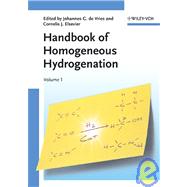
Note: Supplemental materials are not guaranteed with Rental or Used book purchases.
Purchase Benefits
What is included with this book?
| Foreword | |
| Preface | |
| List of Contributors | |
| Introduction: Organometallic Aspects and Mechanism of Homogeneous Hydrogenation | |
| Rhodium (Luis A. Oro and Daniel Carmona) | |
| Introduction | |
| The Early Years (1939-1970) | |
| The [RhH(CO)(PPh3)3] Catalyst | |
| The [RhCl(PPh3)3] Complex and Related Catalysts | |
| The Cationic[Rh(diene)(PR3)X]+ Catalysts | |
| Enantioselective Rhodium Catalysts | |
| Some Dinuclear Catalyst Precursors | |
| Concluding Remark | |
| Abbreviations | |
| References | |
| Iridium (Robert H. Crabtree) | |
| Introduction | |
| Historical Aspects | |
| Organometallic Aspects | |
| Catalysis | |
| Acknowledgments | |
| Abbreviations | |
| References | |
| Ruthenium and Osmium (Robert H. Morris) | |
| Introduction | |
| Ruthenium | |
| Osmium | |
| Acknowledgment | |
| Abbreviations | |
| References | |
| Palladium and Platinum (Paolo Pelagatti) | |
| Introduction | |
| Palladium | |
| Platinum | |
| Abbreviations | |
| References | |
| Nickel (Elisabeth Bouwman) | |
| Introduction | |
| Coordination Chemistry and Organometallic Aspects of Nickel | |
| Hydrogenation Catalysis | |
| Concluding Remarks | |
| Abbreviations | |
| References | |
| Hydrogenation with Early Transition Metal, Lanthanide and Actinide Complexes (Christophe Coperet) | |
| Introduction | |
| Mechanistic Considerations | |
| Group IV Metal Hydrogenation Catalysts | |
| Hydrogenation Catalysts Based on Group III, Lanthanide, and Actinide Complexes | |
| Hydrogenation Catalysts Based on Groups V-VII Transition-Metal Complexes | |
| Supported Early Transition-Metal Complexes as Heterogeneous Hydrogenation Catalysts | |
| Conclusions.Acknowledgments | |
| Abbreviations | |
| References | |
| Ionic Hydrogenations (R. Morris Bullock) | |
| Introduction | |
| Stoichiometric Ionic Hydrogenations | |
| Catalytic Ionic Hydrogenation | |
| Ruthenium Complexes Having an OH Proton Donor and a RuH as Hydride Donor | |
| Catalytic Hydrogenation of Ketones by Strong Bases | |
| Conclusion | |
| Acknowledgments | |
| Abbreviations | |
| References | |
| Homogeneous Hydrogenation by Defined Metal Clusters | |
| Introduction | |
| Hydrogenation of C=C Bonds | |
| Hydrogenation of CC Bonds | |
| Hydrogenation of Other Substrates | |
| Concluding Remarks | |
| Abbreviations | |
| References | |
| Homogeneous Hydrogenation: Colloids - Hydrogenation with Noble Metal Nanoparticles | |
| Introduction | |
| Concepts | |
| Hydrogenation of Compounds with C=C Bonds | |
| Hydrogenation of Compounds with CC Bonds | |
| Arene Hydrogenation | |
| Hydrogenation of Compounds with C=O Bonds | |
| Enantioselective Hydrogenation | |
| Conclusion.Abbreviations.References | |
| Kinetics of Homogeneous Hydrogenations: Measurement and Interpretation | |
| Introduction | |
| The Basics of Michaelis-Menten Kinetics | |
| Hydrogenation From a Kinetic Viewpoint | |
| Abbreviations | |
| References | |
| Spectroscopic Methods in Homogeneous Hydrogenation | |
| Nuclear Magnetic Resonance Spectroscopy in Homogeneous Hydrogenation Research | |
| Introduction | |
| NMR Methods | |
| Outlook.Abbreviations | |
| References | |
| Parahydrogen-Induced Polarization: Applications to Detect Intermediates of Catalytic Hydrogenations | |
| In-Situ Spectroscopy | |
| Ortho- and Parahydrogen | |
| Applications of PHIP-NMR Spectroscopy | |
| Catalyst-Attached Products as | |
| Table of Contents provided by Publisher. All Rights Reserved. |
The New copy of this book will include any supplemental materials advertised. Please check the title of the book to determine if it should include any access cards, study guides, lab manuals, CDs, etc.
The Used, Rental and eBook copies of this book are not guaranteed to include any supplemental materials. Typically, only the book itself is included. This is true even if the title states it includes any access cards, study guides, lab manuals, CDs, etc.